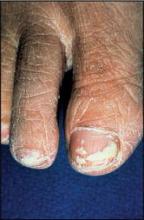MIAMI BEACH – Remain skeptical about new devices or drugs that claim the ability to target fungal infections, recommended Dr. Alan B. Fleischer Jr.
"You are probably going to be barraged by devices that do something for nail fungus," Dr. Fleischer said. "As a physician, try to focus on curing the fungus and not just making them [patients] look better," he said at the South Beach Symposium.
For example, enrollment is underway for a study to assess a 1320-nm Nd:YAG device to fight onychomycosis. However, the primary outcome in the trial is "improved appearance," not fungal cure, he said. "It is confusing ... to a consumer. Improving the appearance sounds similar, but it is not the same."
When it comes to topical treatments for onychomycosis, efinaconazole is in development for treating mild to moderate forms of toenail infection, noted Dr. Fleischer. The manufacturer, Valeant Pharmaceuticals, reported promising results in two international phase III studies in December 2011. However, Valeant has not released mycology results.
"Pay attention to the cure rate when it is approved, probably sometime in the next year," said Dr. Fleischer, professor of dermatology at Wake Forest University in Winston-Salem, N.C.
Patients may ask about natural cures for fungal infections, but the data are generally unconvincing or lacking, Dr. Fleischer said. For example, some people advocate melaleuca oil from the tea tree to clear tinea pedis. However, when 104 patients were randomized to creams containing 10% melaleuca oil, 1% tolnaftate, or placebo, "melaleuca oil cleared 30% of subjects of tinea pedis. That is very low," he said (Australas. J. Dermatol. 1992;33:145-9). Of the tolnaftate-treated patients, 85% had a negative culture at the end of therapy, and 21% of placebo patients were considered cleared.
Other patients might ask about using vinegar to cure foot fungus. They may have read about this natural remedy on the Internet, where a Google search for the keywords "vinegar" and "foot fungus" yields about 116,000 results. "Although there are no data, topical vinegar immersion probably does something," Dr. Fleischer said.
"Fungal infections are still out there, but new drugs and modalities are continually evolving," he added.
Dr. Fleischer disclosed that he is a consultant for Intendis and Upsher-Smith Laboratories. He is also a researcher for Abbott, Amgen, Astellas, Galderma, GlaxoSmithKline, Intendis, and Pfizer. He receives a salary from Merz Pharma.


